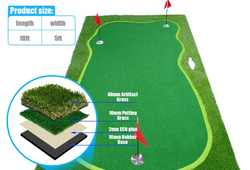

The maintenance of the putting green should focus on three core goals: lawn health, flatness, and ball speed. Combined with daily maintenance and regular deep care, the specific methods can be classified into the following categories:
1. Daily basic maintenance (high-frequency operation, performed daily or every other day)
Cutting
Frequency: During the hot summer period (rapid growth), it should be done once a day; in spring and autumn (slow growth), it should be done once every other day. In winter, depending on the type of lawn (such as cool-season grass), it can be done 3-5 times a week.
Height: The trimming height of the putting green grass (such as creeping bentgrass, dwarf tiger grass) should be controlled at 3-5 millimeters (about the thickness of a coin), ensuring a dense lawn without damaging the growth points.
Tools: Use a roller-type putting green mower. After trimming, clean up the grass clippings promptly to avoid affecting the ball's rolling. Irrigation
Timing: Morning (6-8 am) or evening (1 hour after sunset), avoiding high-temperature evaporation at noon or waterlogging at night which may cause diseases.
Amount: Maintain the soil surface (5-10 cm) moist but not muddy. It should be such that when you pinch the soil, it can form a ball and disintegrate easily when you gently rub it; avoid excessive irrigation which may cause lawn overgrowth or root rot.
Method: Prioritize using rotary micro-sprinklers to evenly cover the putting green to prevent local drought or waterlogging.
Rolling
Frequency: After daily mowing or 1-2 days before an event, use a 200-300 kg putting green roller to roll 1-2 times.
Purpose: Compact the soil, smooth the surface of the lawn, improve the flatness of the putting green and the ball speed (the ball speed usually increases by 10%-15% after rolling).
II. Regular deep maintenance (periodic operation, adjusted according to the condition of the lawn)
Drilling for ventilation
Frequency: 2-3 times a year (mainly in spring and autumn, avoiding high temperatures in summer or low temperatures in winter), can increase 1 time when soil compaction is severe.
Method: Use a hollow drilling machine (hole depth 8-12 cm, hole diameter 6-10 mm) to evenly drill holes on the putting green, remove the soil core (grass plug) from the holes, and then spread fine sand (particle size 0.2-0.5 mm) to fill the holes.
Purpose: Break soil compaction, increase air permeability, promote deep root growth, reduce waterlogging and disease occurrence.
Sanding and weeding
Sanding: Conduct once after drilling or every 1-2 months, spread fine sand (particle size 0.2-0.5 mm) at a thickness of 2-3 mm, level it with a drag net, allowing the sand to penetrate the gaps in the lawn. The purpose is to level the surface, enhance the wear resistance of the lawn, and inhibit weed growth.
Weeding (vertical cutting): Conduct once every 2-3 months, use a weeding machine to remove the top layer of dead grass (thickness over 5 mm) on the lawn, preventing the dead grass layer from hindering the penetration of water and nutrients, and reducing the occurrence of diseases.
Fertilization and disease control
Fertilization: Mainly use slow-release compound fertilizer (nitrogen: phosphorus: potassium ratio approximately 3:1:2), once a month in spring and autumn, reduce or stop in summer (high-temperature period) and winter (dormancy period); regularly supplement trace elements (such as iron, magnesium), to avoid yellowing of the lawn.
Disease control: Common diseases (such as spot blight, botrytis blight) are mainly "prevention-oriented", spray protective fungicides every 10-15 days during high-temperature and high-humidity seasons; after discovering disease spots, promptly spray therapeutic agents to prevent spread.
III. Special maintenance (before events / extreme weather)
Preparation before events
Stop fertilizing 2-3 days before, to avoid overly green or excessive growth of the lawn affecting the ball speed;
Increase 1 roll 1 day before the event to ensure the flatness of the putting green;
Clear fallen leaves, stones, and other debris on the putting green, repair ball marks (use ball mark repairer to lift the turf and press it down firmly).
Extreme weather response
High temperature and drought: Increase irrigation frequency (such as 1 time each in the morning and evening), provide shade (set up shading nets), to avoid lawn burning;
Heavy rain and waterlogging: Timely drain the water on the putting green (open the drainage system or manually sweep the water), check for any erosion of depressions after the rain, and promptly add sand to level it;
Low temperature and frost damage: Spray antifreeze agent before winter arrives, avoid stepping on the frozen lawn after freezing, and water immediately after thawing to alleviate drought.
IV. Key precautions
Avoid frequent trampling of the putting green: Set up dedicated passages, prohibit non-custodial personnel from entering at will;
Regularly monitor the condition of the lawn: Observe the color of the lawn (yellowing may indicate nutrient deficiency / drought), density (sparse may require reseeding), and the number of ball marks (too many may require enhanced repair), and promptly adjust the maintenance plan;
Tool maintenance: The blade of the lawn mower needs to be regularly ground (to ensure sharpness, avoid tearing the grass leaves), clean and maintain the drilling machine, roller machine, etc. after use, to extend their lifespan.









